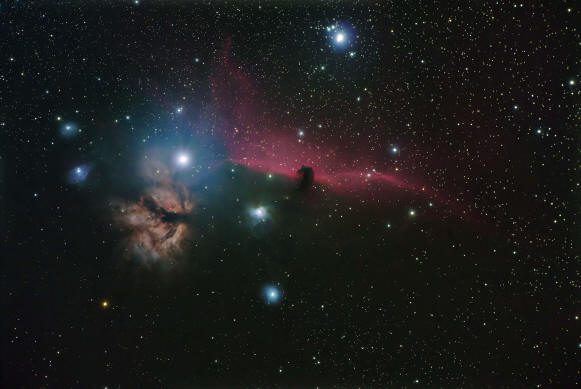|
The Night Sky of January
Dr. Wayne Wooten
Professor of Astronomy
For January 2011, the Moon will be new on January 4th. The first two weeks find the moon waxing in the evening sky. The waxing crescent moon passes just north of Jupiter on January 9th, and is first quarter moon sits high in the sky
on the evening of January 12th. The full moon is on January 19th, for northern Indian tribes, this was the Wolf or Snow Moon….before global warning, obviously….. The last quarter moon passes south of Saturn on January 25th. The waning crescent moon passes just below
Venus in the dawn sky on January 30th.
Venus dominates the dawn sky in January, rising about two hours before the sun. Mars and Mercury lurk too close to the Sun for naked eye viewing this month. But Jupiter is still well placed in the SW sky through February. Saturn
rises about midnight, and the famed rings are still very thin, but starting to open up week by week! They were edge on as seen from the Earth in 2009, and will be tilted 27 degrees toward us at solstice in 2017, when they will double the planet’s present brightness.
Saturn is in the morning sky in Virgo near Spica now, but comes to opposition and moves into evening sky by late March.
The square of Pegasus dominates the western sky. The constellation Cassiopeia makes a striking W in the NW. She contains many nice star clusters for binocular users in her outer arm of our Milky Way, extending to the NE now. Her
daughter, Andromeda, starts with the NE corner star of Pegasus’’ Square, and goes NE with two more bright stars in a row. It is from the middle star, beta Andromeda, that we proceed about a quarter the way to the top star in the W of Cassiopeia, and look for a faint
blur with the naked eye. M-31, the Andromeda Galaxy, is the most distant object visible with the naked eye, lying about 2.5 million light years distant. Overhead is Andromeda’s hero, Perseus, rises. Between him and Cassiopeia is the fine Double Cluster, faintly
visible with the naked eye and two fine binocular objects in the same field. Perseus contains the famed eclipsing binary star Algol, where the Arabs imagined the eye of the gorgon Medusa would lie. It fades to a third its normal brightness for six out of every 70
hours, as a larger but cooler orange giant covers about 80% of the smaller but hotter and thus brighter companion as seen from Earth.

Orion's famed dark nebula, The Horsehead, and the brighter Flame Nebula
Look at Perseus’ feet for the famed Pleiades cluster; they lie about 400 light years distant, and over 250 stars are members of this fine group. East of the seven sisters is the V of stars marking the face of Taurus the Bull, with
bright orange Aldebaran as his eye. The V of stars is the Hyades cluster, older than the blue Pleaides, but about half their distance. Mars now lies in the horns of Taurus as January begins, and was at greatest brilliance at opposition around last Christmas.
Yellow Capella, a giant star the same temperature and color as our much smaller Sun, dominates the overhead sky. It is part of the pentagon on stars making up Auriga, the Charioteer (think Ben Hur). Several nice binocular Messier
open clusters are found in the winter milky way here. East of Auriga, the twins, Castor and Pollux highlight the Gemini. UWF alumni can associate the pair with Jason and the Golden Fleece legend, for they were the first two Argonauts to sign up on his crew of
adventurers.
South of Gemini, Orion is the most familiar winter constellation, dominating the eastern sky at dusk. The reddish supergiant Betelguese marks his eastern shoulder, while blue-white supergiant Rigel stands opposite on his west knee.
Just south of the belt, hanging like a sword downward, is M-42, the Great Nebula of Orion, an outstanding binocular and telescopic stellar nursery. It is part of a huge spiral arm gas cloud, with active starbirth all over the place. Our image this month is of the
nearby belt of Orion includes the famed dark nebula, The Horsehead, and the brighter Flame Nebula, around the eastern end of the Belt. It was taken under the dark skies in Texas last month.
Last but certainly not least, in the east rise the hunter’s two faithful companions, Canis major and minor. Procyon is the bright star in the little dog, and rises minutes before Sirius, the brightest star in the sky. Sirius
dominates the SE sky by 7 PM, and as it rises, the turbulent winter air causes it to sparkle with shafts of spectral fire. Beautiful as the twinkling appears to the naked eye, for astronomers this means the image is blurry; only in space can we truly see "clearly
now". At 8 light years distance, Sirius is the closest star we can easily see with the naked eye from West Florida. You must be in south Florida to spot Alpha Centauri on June evenings. Below Sirius in binoculars is another fine open cluster, M-41, a fitting dessert
for New Year’s sky feast.
Read past issues of the Sky at Night
|